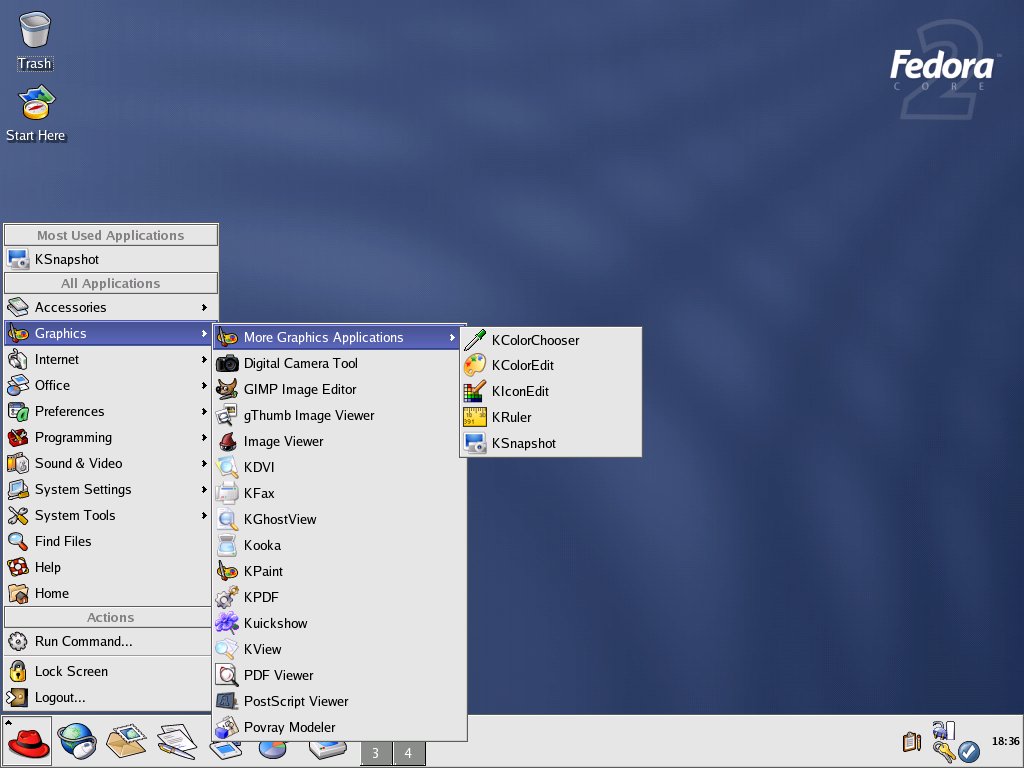Page 2
Fedora Core 2 comes with 3 desktop environments: GNOME, KDE, and XFce4.
GNOME
GNOME 2.6.0 has several new features, including a newly enhanced version of Nautilus.

There is now a new "computer" icon on the desktop, which brings together file system, removable media, and network shares. The automount function has been also improved and supports now some USB devices.

Red Hat's GNOME desktop comes with the usual applications. Mozilla 1.6 (left), has some new features such as a tab confirm close dialog. Ximian Evolution 1.4.6 (right) is a bug fixing release, there are no new features since 1.4.5 from Fedora Core 1

OpenOffice 1.1.1 (left) is primary a bug fixing release, while GIMP 2.0.1 (right) is a new major release of the popular image manipulation program
Rhythmbox is an integrated music management application, based on the GStreamer media framework
KDE
KDE 3.2.2 has increased performance and standards compliance over the older KDE 3.1.4 release, including lowered start up times for applications.

The "Windows" key can be used to open the start menu (left). Red Hat's KDE port comes still only the old Bluecurve theme (right).

Konqueror (left) has enhancements from Apple Computer Inc.'s Safari web browser team. Some of the graphical applications in KDE (right)
K3b is a powerful CD and DVD burning application and new in Fedora Core
XFce4
XFce4 is a lightweight desktop environment based on the GTK+ toolkit version 2. Unfortunately, the Fedora developer team forgot to add XFce4 to anaconda's software selector and add/remove applications.
To install XFce4 manually, you need CD 3 & 4 or the DVD
1.) Open a shell window, switch to root, and create a directory:
su -
mkdir xfce4
2.) Insert CD 3 and run:
cd /mnt/cdrom/Fedora/RPMS
cp dbh-1.0.18-2.i386.rpm /root/xfce4
cp dbh-devel-1.0.18-2.i386.rpm /root/xfce4
cp libxfce4mcs-4.0.5-2.i386.rpm /root/xfce4
cp libxfce4mcs-devel-4.0.5-2.i386.rpm /root/xfce4
cp libxfce4util-4.0.5-1.i386.rpm /root/xfce4
cp libxfce4util-devel-4.0.5-1.i386.rpm /root/xfce4
cp libxfcegui4-4.0.5-1.i386.rpm /root/xfce4
cp libxfcegui4-devel-4.0.5-1.i386.rpm /root/xfce4
cd /
3.) Insert CD 4 and run:
cd /mnt/cdrom/Fedora/RPMS
cp xfce4-panel-4.0.5-2.i386.rpm /root/xfce4
cp xfce-mcs-manager-4.0.5-1.i386.rpm /root/xfce4
cp xfce-mcs-manager-devel-4.0.5-1.i386.rpm /root/xfce4
cp xfce-mcs-plugins-4.0.5-2.i386.rpm /root/xfce4
cp xfce-utils-4.0.5-1.i386.rpm /root/xfce4
cp xfdesktop-4.0.5-2.i386.rpm /root/xfce4
cp xffm-4.0.5-1.i386.rpm /root/xfce4
cp xffm-icons-4.0.5-1.i386.rpm /root/xfce4
cp xfwm4-4.0.5-2.i386.rpm /root/xfce4
cp xfwm4-themes-4.0.5-1.noarch.rpm /root/xfce4
cd /
4.) To install the packages run:
cd /root/xfce4
rpm -ivh *.rpm
XFce 4 is now ready to use
Here two screen shots:


XFce Settings Manager with Bluecurve theme (left) and more settings (right)
XFce 4 is much faster than GNOME/KDE, especially on older machines with 128MB or less. Hopefully, this is an install option in the next Fedora Core release
Server Software
Fedora Core 2 includes the following server software: Apache 2.0.49 with PHP 4.3.4, Perl 5.8.3, Bind 9.2.3, Postfix 2.0.18, MySQL 3.23.58, PostgreSQL 7.4.2, Samba 3.0.3, and Subversion 1.0 (replace CVS).
Conclusion
Fedora Core 2 is overall a pretty good Linux distribution for beginners and advanced users. I haven't found any critical bugs in this release so far.
For more information about the Fedora Project visit:
http://fedora.redhat.com
